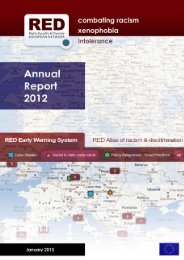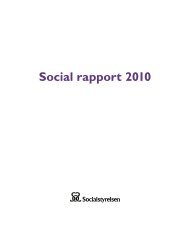R18PITFALLS AND BIASTABLE 2. Placement <strong>of</strong> students with special educational needs relative to population <strong>of</strong> students withspecial educational needsPercent SEN Percent in Percent in Percentspecial schools special classes fully included2008** 2008** 2008** 2008**CZ 8.6 41 11.7 47.3FI 8.0 16 33 51FR 2.7 22.3 46.7 31HU 5.8 50 No data available 50IT 2.3 99.5SK† 7.7 47 18 35UK 2.8 41 9 51** SO<strong>UR</strong>CE: Watkins (2008).† 2001 data from Meijer, Soriano, <strong>and</strong> Watkins (2003); 2008 data from Eurydice (2009a).TABLE 3. Placement <strong>of</strong> students diagnosed with intellectual disability relative to total student populationPercent in Percent in Percent inspecial schools special classes st<strong>and</strong>ard schoolsCZ 2.86 0.08 0FI 1.04 0.08 .17FR 0.26 0.47 .15HU 4.63 2.58 0IT 0 0 >99.9UK with statement: 0.46 – 1.70without statement: 0.09 – 14.32SO<strong>UR</strong>CE: Organisation for Economic Co-operation <strong>and</strong> Development (2001).Legislation for all countries discussed in this policy paper includes provisions for children diagnosed with mildintellectual disability to be taught in special classes in mainstream schools. Finl<strong>and</strong>, France, Italy, <strong>and</strong> <strong>the</strong> UnitedKingdom, as well as Serbia, have had this provision for at least a decade, with relevant provisions in place in Italysince 1971. This provision has been incorporated into <strong>the</strong> legislation <strong>of</strong> <strong>the</strong> Czech Republic, Hungary, <strong>and</strong> Slovakiasince <strong>the</strong> early 2000s. Because this provision is relatively new for <strong>the</strong>se countries, it might be expected that rates<strong>of</strong> inclusion would rise over time. Between 2001 <strong>and</strong> 2008, here have been slightly decreased rates <strong>of</strong> segregationin <strong>the</strong> Czech Republic <strong>and</strong> Hungary, but a slight increase in segregation in Slovakia. Special classes in mainstream
R19schools are more prevalent in Finl<strong>and</strong> <strong>and</strong> France, while <strong>the</strong> Czech Republic, Finl<strong>and</strong>, Hungary, <strong>and</strong> <strong>the</strong> UnitedKingdom fully include almost or just 50 percent <strong>of</strong> <strong>the</strong>ir pupils with disabilities in mainstream schools. Pupils withmild intellectual disability are less apt to be included than <strong>the</strong>ir sensory-, physically-, speech-, or learning-disabledpeers. A 2001 study by <strong>the</strong> Organisation for Economic Co-Operation <strong>and</strong> Development (OECD) reports that in nocountry were all pupils with intellectual disabilities included in mainstream education, with <strong>the</strong> highest percentage,over 99 percent, in Italy, 16 percent <strong>of</strong> pupils in <strong>the</strong> United Kingdom, <strong>and</strong> zero percent in Czech Republic <strong>and</strong> Hungary.The above data are based on a cross-national disability classification system developed by <strong>the</strong> OECD in orderto document how countries classify children <strong>and</strong> allocate special educational needs resources (Florian et al. 2006,40). The three categories <strong>of</strong> this taxonomy established by OECD are: Cross-National Category A, needs arisingfrom impairments; Cross-National Category B, needs from learning or behavior difficulties; <strong>and</strong> Cross-NationalCategory C, (social) disadvantage (OECD 2001, 176). This taxonomy is one-dimensional <strong>and</strong> does not take intoaccount <strong>the</strong> complexities <strong>of</strong> children’s characteristics, including demographics or how different countries interpret<strong>the</strong>se characteristics (Florian et al. 2006, 40). The countries also report different disabilities or difficulties differently.For example, Cross-National Category A typically encompasses subcategories for, among o<strong>the</strong>rs, visual impairment,hearing impairment, orthopedic impairment, autism, speech impairments, health impairments, <strong>and</strong> mild,moderate, <strong>and</strong> severe intellectual disabilities, but Cross-National Category B might include mild learning difficulties<strong>and</strong> learning disabilities. For example, Hungary has two categories for mental impairment: Cross-NationalCategory A, Category 1: Moderate degree <strong>of</strong> mental disability, <strong>and</strong> Cross-National Category B, Category 7, milddegree <strong>of</strong> mental disability (learning disability) (OECD 2007, 58–59). A difficulty in analyzing data is that whendata are reported in OECD publications, <strong>the</strong> subcategories for “Category A” <strong>and</strong> “Category B” are largely reportedtoge<strong>the</strong>r, <strong>and</strong> rarely are <strong>the</strong> different types <strong>of</strong> disabilities disaggregated from <strong>the</strong> main categories used by eachcountry. There is a need for a comprehensive overview <strong>of</strong> school placements where <strong>the</strong> data contained in <strong>the</strong>different categories <strong>and</strong> subcategories <strong>of</strong> each country are disaggregated to get a more robust description <strong>of</strong> <strong>the</strong>different types <strong>of</strong> inclusion practiced in different countries, <strong>and</strong> specifically, how children with different types <strong>of</strong>intellectual disability diagnoses (mild, moderate, or severe) are placed in schools.
- Page 3 and 4: R3CONTENTSACKNOWLEDGMENTS 4EXECUTIV
- Page 5 and 6: R5EXECUTIVE SUMMARYThis policy pape
- Page 7: R7For Romani children in Central an
- Page 10 and 11: R10PITFALLS AND BIAS4. Discontinue
- Page 12 and 13: R12PITFALLS AND BIASINTRODUCTIONThe
- Page 14 and 15: R14PITFALLS AND BIASa child is read
- Page 16 and 17: R16PITFALLS AND BIASthe child (Ryan
- Page 20 and 21: R20PITFALLS AND BIASAMONG THE ROOTS
- Page 22 and 23: R22PITFALLS AND BIASTAXONOMY OF “
- Page 24 and 25: R24PITFALLS AND BIASdevelop the ver
- Page 26 and 27: R26PITFALLS AND BIAS2008, 136). Ard
- Page 28 and 29: R28PITFALLS AND BIASBias in test ad
- Page 30 and 31: R30PITFALLS AND BIASWhile the test
- Page 32 and 33: R32PITFALLS AND BIASOF ROMANI CHILD
- Page 34 and 35: R34PITFALLS AND BIAStwo distinct ty
- Page 36 and 37: R36PITFALLS AND BIASPOLICY AND PRAC
- Page 38 and 39: R38PITFALLS AND BIASand had to repe
- Page 40 and 41: R40PITFALLS AND BIASOrientation Tes
- Page 42 and 43: R42PITFALLS AND BIASTABLE 5. Educat
- Page 44 and 45: R44PITFALLS AND BIASCOUNTRY-SPECIFI
- Page 46 and 47: R46PITFALLS AND BIASPLACEMENT IN SP
- Page 48 and 49: R48PITFALLS AND BIASCompulsory scho
- Page 50 and 51: R50PITFALLS AND BIASand Educational
- Page 52 and 53: R52PITFALLS AND BIAS121.1.cc.ii). A
- Page 54 and 55: R54PITFALLS AND BIASTest of School
- Page 56 and 57: R56PITFALLS AND BIASof the overall
- Page 58 and 59: R58PITFALLS AND BIASAS WITH OTHER C
- Page 60 and 61: R60PITFALLS AND BIASfirst grade, or
- Page 62 and 63: R62PITFALLS AND BIASbases listed in
- Page 64 and 65: R64PITFALLS AND BIASof Societies in
- Page 66 and 67: R66PITFALLS AND BIASTABLE 13. Pupil
- Page 68 and 69:
R68PITFALLS AND BIASROMANI CHILDREN
- Page 70 and 71:
R70PITFALLS AND BIASdetermined to c
- Page 72 and 73:
R72PITFALLS AND BIASdeveloped in th
- Page 74 and 75:
R74PITFALLS AND BIASWechsler Intell
- Page 76 and 77:
R76PITFALLS AND BIAStheir chances t
- Page 78 and 79:
R78PITFALLS AND BIASREPRESENTATION
- Page 80 and 81:
R80PITFALLS AND BIASTABLE 20.Enroll
- Page 82 and 83:
R82PITFALLS AND BIAS
- Page 84 and 85:
R84PITFALLS AND BIASGOOD PRACTICE A
- Page 86 and 87:
R86PITFALLS AND BIASStudent assessm
- Page 88 and 89:
R88PITFALLS AND BIASThe United King
- Page 90 and 91:
R90PITFALLS AND BIASor assistance i
- Page 92 and 93:
R92PITFALLS AND BIASTeachers report
- Page 94 and 95:
R94PITFALLS AND BIASTHE DETERMINATI
- Page 96 and 97:
R96PITFALLS AND BIASintellectual di
- Page 98 and 99:
R98PITFALLS AND BIAS8. Ensure that
- Page 100 and 101:
R100PITFALLS AND BIASANNEX 1:RELIAB
- Page 102 and 103:
R102PITFALLS AND BIAS1. Does the te
- Page 104 and 105:
R104PITFALLS AND BIASANNEX 2:COMPON
- Page 106 and 107:
R106PITFALLS AND BIASFIGURE A4. Sam
- Page 108 and 109:
R108PITFALLS AND BIASAshton-Warner,
- Page 110 and 111:
R110PITFALLS AND BIASCahn, Claude,
- Page 112 and 113:
R112PITFALLS AND BIASD.H. and Other
- Page 114 and 115:
R114PITFALLS AND BIASFigueroa, Rich
- Page 116 and 117:
R116PITFALLS AND BIASGovernment of
- Page 118 and 119:
R118PITFALLS AND BIASHayman, Robert
- Page 120 and 121:
R120PITFALLS AND BIASKovács-Cerovi
- Page 122 and 123:
R122PITFALLS AND BIASMacura-Milovan
- Page 124 and 125:
R124PITFALLS AND BIASMoore, Tom. 20
- Page 126 and 127:
R126PITFALLS AND BIASRadivojevic, D
- Page 128 and 129:
R128PITFALLS AND BIASShepard, Lorri
- Page 130 and 131:
R130PITFALLS AND BIASTomatová, Jan
- Page 132 and 133:
R132PITFALLS AND BIASVláda Česká
- Page 134:
Copyright © 2012 Roma Education Fu




